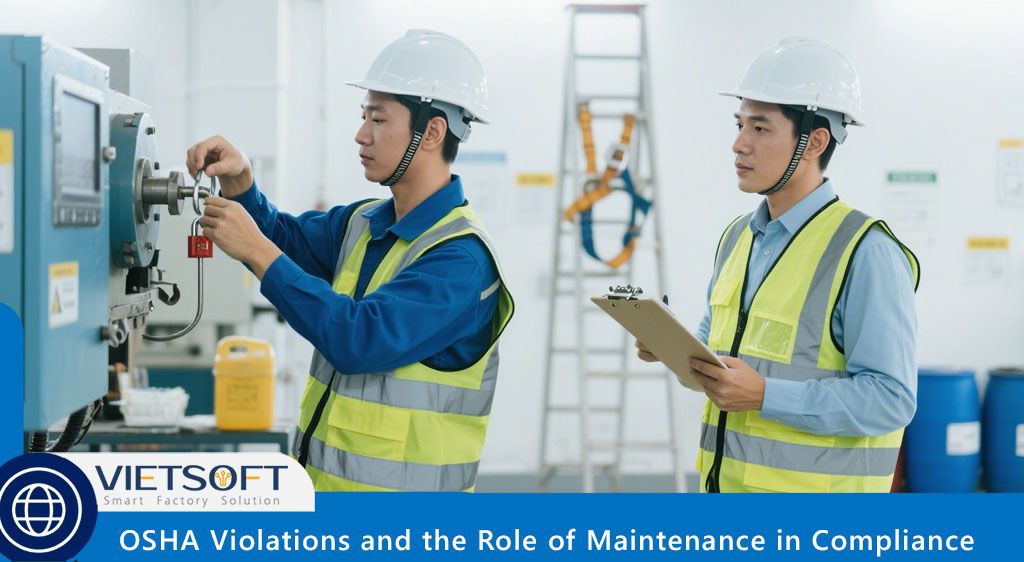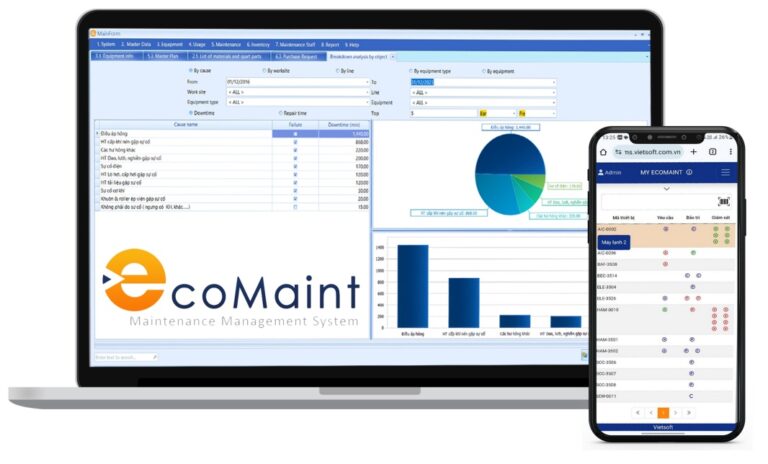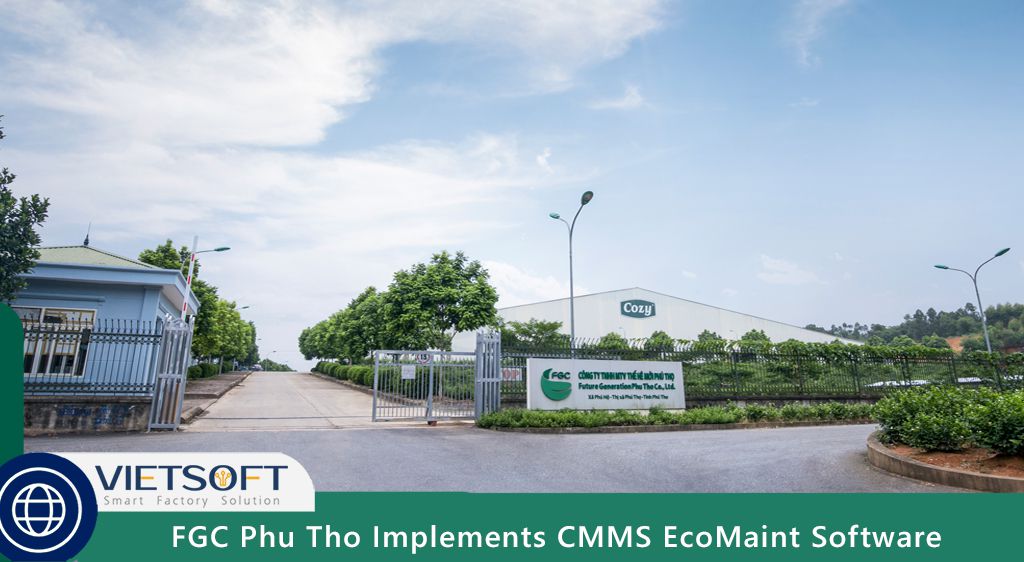
Workplace safety is a cornerstone of operational excellence, particularly in industries like manufacturing, where maintenance teams play a pivotal role in ensuring compliance with Occupational Safety and Health Administration (OSHA) standards. OSHA violations can lead to severe consequences, including hefty fines, operational disruptions, and, most critically, worker injuries or fatalities. In 2024, OSHA reported over 30,000 violations across industries, with manufacturing sectors accounting for a significant portion due to the high-risk nature of their operations. For maintenance teams, understanding these violations and implementing proactive strategies to avoid them is not just about compliance—it’s about fostering a culture of safety and responsibility.
This comprehensive guide explores the concept of OSHA violations, the critical role of maintenance teams in avoiding them, and actionable strategies to ensure compliance.
I. What Are OSHA Violations?
OSHA violations occur when employers fail to comply with the standards set by the Occupational Safety and Health Act of 1970, designed to ensure safe and healthy working conditions. These violations range from minor infractions, like improper documentation, to severe breaches, such as neglecting critical safety protocols, which can result in penalties exceeding $15,000 per serious violation in 2025, with willful violations reaching up to $161,323 per instance.
Maintenance teams, responsible for equipment upkeep and facility safety, are often at the forefront of OSHA inspections. Common violations in maintenance-heavy environments include inadequate lockout/tagout procedures, missing machine guards, and poor hazard communication. These issues not only risk fines but also endanger workers, with OSHA estimating that compliance with safety standards could prevent thousands of injuries annually.
II. Why Maintenance Teams Are Key to Avoiding OSHA Violations
Maintenance teams interact daily with machinery, chemicals, and high-risk environments, making them critical to compliance. Their role extends beyond repairs to proactively identifying and mitigating hazards. By implementing robust safety protocols and leveraging modern tools, maintenance teams can significantly reduce the risk of violations, creating a safer workplace while avoiding costly penalties.
III. Key OSHA Violations and Maintenance Strategies
Below, we explore the most common OSHA violations relevant to maintenance teams and provide detailed strategies to avoid them, ensuring compliance and safety.
1. Lockout/Tagout (LOTO): Controlling Hazardous Energy
Why It Matters
Lockout/Tagout violations consistently rank among OSHA’s top citations, with over 2,000 violations in 2024. These violations occur when maintenance teams fail to properly isolate energy sources during equipment servicing, risking catastrophic accidents like electrocutions or amputations. OSHA estimates that proper LOTO compliance prevents approximately 120 fatalities and 50,000 injuries annually.
Maintenance Strategies to Avoid OSHA Violations
- Develop Comprehensive LOTO Procedures: Create detailed, equipment-specific LOTO protocols. For example, a hydraulic press might require isolating electrical, hydraulic, and pneumatic energy sources. Document each step, such as disconnecting power, applying locks, and verifying a zero-energy state.
- Train and Retrain Staff: Conduct annual LOTO training, ensuring technicians understand the dangers of hazardous energy and the correct use of lockout devices like padlocks and hasps. Use real-world scenarios, such as servicing a conveyor belt, to reinforce training.
- Implement a No-Shortcuts Culture: Emphasize that bypassing LOTO for quick fixes is unacceptable. For instance, a technician might be tempted to skip LOTO to restart a production line swiftly, but this risks severe injury. Regular safety briefings can reinforce this mindset.
- Use Digital Tools for Compliance: Tools like Vietsoft’s EcoMaint CMMS can automate LOTO procedure documentation, schedule training reminders, and track compliance, ensuring no steps are missed.
Benefits of Compliance
Effective LOTO programs prevent accidents, reduce downtime from injuries, and demonstrate a commitment to safety during OSHA inspections, avoiding costly fines.
2. Machine Guarding: Protecting Against Moving Parts
Why It Matters
Machine guarding violations, cited 1,644 times in 2023, occur when guards are missing, improperly installed, or bypassed during operation. Maintenance teams often remove guards for repairs, but failing to reinstall them can lead to severe injuries like amputations.
Maintenance Strategies to Avoid OSHA Violations
- Routine Guard Inspections: Incorporate guard checks into daily or weekly maintenance schedules. For example, ensure guards on belts, pulleys, and blades are secure and undamaged.
- Post-Maintenance Protocols: After servicing equipment, mandate that technicians verify guard reinstallation before re-energizing. For instance, a technician repairing a milling machine must confirm all guards are back in place.
- Use Checklists: Implement digital checklists via a CMMS to ensure guards are inspected and reinstalled. This reduces human error and provides auditable records.
- Address Design Flaws: If guards are frequently removed due to design issues, collaborate with engineering teams to redesign equipment for easier access without compromising safety.
Benefits of Compliance
Proper guarding prevents contact with hazardous moving parts, reducing injury risks and ensuring compliance with OSHA standard 1910.212.
3. Hazard Communication: Managing Chemical Risks
Why It Matters
Hazard Communication (HazCom) violations, among OSHA’s top three citations, involve improper labeling, missing Safety Data Sheets (SDSs), or inadequate training. Maintenance teams handle chemicals like lubricants and solvents, making HazCom compliance critical.
Maintenance Strategies to Avoid OSHA Violations
- Maintain a Chemical Inventory: Keep an updated list of all chemicals used in maintenance, with accessible SDSs. For example, a solvent used for degreasing should have an SDS readily available in a digital or physical binder.
- Label All Containers: Ensure secondary containers, like spray bottles, are clearly labeled with chemical names and hazard warnings. Replace faded or missing labels immediately.
- Train for Safety: Provide regular training on chemical hazards, PPE requirements, and emergency procedures. For instance, technicians should know the risks of a specific cleaner and how to access its SDS.
- Leverage Technology: Use a CMMS like EcoMaint to store SDSs digitally, provide QR code access to chemical information, and schedule training, ensuring compliance is streamlined.
Benefits of Compliance
A robust HazCom program protects workers from chemical exposures, improves emergency preparedness, and avoids OSHA citations.
4. Personal Protective Equipment (PPE): Ensuring Proper Use
Why It Matters
PPE violations, with over 1,800 citations in 2024, occur when maintenance workers lack appropriate protective gear for tasks like grinding or chemical handling. Inadequate PPE can lead to injuries like eye damage or respiratory issues.
Maintenance Strategies to Avoid OSHA Violations
- Enforce PPE Rules: Mandate safety glasses in all shop areas and add face shields for high-risk tasks like cutting. Provide task-specific gloves, such as chemical-resistant gloves for handling solvents.
- Implement Respiratory Protection Programs: For tasks involving fumes, conduct fit testing and provide cartridge respirators, not just dust masks. For example, welding tasks may require a full-face respirator.
- Maintain PPE Quality: Regularly inspect PPE for wear and tear, replacing damaged items promptly. Use a CMMS to schedule inspections and track inventory.
- Train for Compliance: Educate workers on correct PPE use, such as how to wear a harness properly for elevated work, ensuring compliance with OSHA standards.
Benefits of Compliance
Consistent PPE use prevents injuries, enhances worker confidence, and demonstrates compliance during OSHA inspections.
5. Powered Industrial Trucks: Ensuring Safe Forklift Operations
Why It Matters
Forklift-related violations, cited over 1,900 times in 2024, stem from untrained operators, unsafe driving, or inadequate maintenance. Maintenance teams often use forklifts, making their role in compliance critical.
Maintenance Strategies to Avoid OSHA Violations
- Certify Operators: Ensure all forklift operators receive OSHA-compliant training every three years. For example, a technician using a forklift to move parts must be certified.
- Conduct Daily Inspections: Use a pre-shift checklist to verify brakes, horns, and safety devices. Tag out defective forklifts until repaired.
- Enforce Safe Practices: Mandate seatbelt use and prohibit unauthorized riders. For instance, a technician should never allow a coworker to ride on a forklift’s forks.
- Track Maintenance Records: Use a CMMS to log forklift inspections and repairs, ensuring compliance and readiness for OSHA audits.
Benefits of Compliance
Safe forklift operations prevent accidents like tip-overs, reduce downtime, and avoid OSHA penalties.
6. Fall Protection and Ladder Safety: Preventing Falls
Why It Matters
Fall protection violations, with over 2,500 citations in 2024, are common in maintenance tasks involving ladders or elevated work. Falls can result in severe injuries or fatalities.
Maintenance Strategies to Avoid OSHA Violations
- Train on Ladder Safety: Educate technicians on proper ladder use, such as maintaining three points of contact and using fiberglass ladders for electrical work.
- Implement Fall Protection: For work above 4 feet without guardrails, provide harnesses and anchor points. For example, a technician servicing an HVAC unit on a roof needs a harness tied to a secure anchor.
- Inspect Equipment: Regularly check ladders and fall protection gear for defects, tagging out damaged items. Use a CMMS to schedule these inspections.
- Use Proper Equipment: Opt for platform lifts over ladders for extended elevated work, ensuring compliance with OSHA 1910.28.
Benefits of Compliance
Effective fall protection prevents life-altering injuries, enhances safety culture, and avoids OSHA citations.
7. Proactive Auditing and Training: Building a Safety Culture
Why It Matters
Ongoing vigilance is essential for OSHA compliance. Inadequate training or documentation can lead to citations, as OSHA expects continuous improvement in safety practices.
Maintenance Strategies to Avoid OSHA Violations
- Conduct Regular Audits: Perform monthly safety walkthroughs using OSHA-aligned checklists. Involve technicians to increase awareness and identify hazards like cluttered workspaces.
- Document Training: Maintain records of all safety training, including LOTO, HazCom, and forklift certifications. Use a CMMS to track completion and schedule renewals.
- Promote Safety Leadership: Encourage supervisors to prioritize safety over speed, recognizing technicians who uphold safety standards. For example, reward a technician who reports a missing guard promptly.
- Leverage Technology: Tools like EcoMaint CMMS can automate audit schedules, store training records, and generate inspection-ready reports, simplifying compliance.
Benefits of Compliance
A proactive safety culture reduces violations, fosters employee trust, and prepares facilities for OSHA inspections.
IV. The Role of CMMS in Avoiding OSHA Violations
A Computerized Maintenance Management System (CMMS) like Vietsoft’s EcoMaint is a game-changer for maintenance teams aiming to avoid OSHA violations. By digitizing safety protocols, EcoMaint streamlines compliance efforts, enhances efficiency, and reduces human error. Here’s how it supports maintenance teams:
- Automated Preventive Maintenance: Schedule regular inspections for guards, forklifts, and PPE, ensuring no task is overlooked.
- Centralized Documentation: Store LOTO procedures, SDSs, and training records in one accessible platform, ready for OSHA audits.
- Real-Time Tracking: Assign and monitor safety tasks, with alerts for overdue certifications or inspections.
- Data-Driven Insights: Analyze equipment maintenance histories to identify recurring issues, preventing violations before they occur.
- Mobile Accessibility: Provide technicians with instant access to safety protocols via mobile devices, enhancing compliance on the go.
To explore how EcoMaint can transform your maintenance operations and ensure OSHA compliance, Discover CMMS EcoMaint here.
Contact us via hotline: 0986778578 or email: sales@vietsoft.com.vn.
V. Emerging Trends in Maintenance for OSHA Compliance
As of 2025, maintenance teams face new challenges and opportunities in OSHA compliance:
- IoT Integration: Sensors on equipment can alert teams to potential hazards, like a loose guard, in real-time, reducing violation risks.
- AI-Powered Analytics: AI tools within CMMS platforms can predict maintenance needs, ensuring equipment is always compliant.
- Sustainability and Safety: Eco-friendly maintenance practices, like using non-toxic chemicals, align with OSHA’s HazCom standards while supporting green initiatives.
- Remote Training: Virtual reality (VR) training programs for LOTO and PPE use are gaining traction, offering immersive, hands-on learning.
VI. Conclusion: Safety as a Maintenance Priority
Avoiding OSHA violations is not just about dodging fines—it’s about protecting workers and fostering a culture of safety. Maintenance teams, as the backbone of facility operations, play a critical role in this mission. By implementing robust LOTO programs, maintaining guards, ensuring proper chemical handling, and leveraging tools like Vietsoft’s EcoMaint CMMS, teams can transform compliance into a seamless part of their workflow.
Safety and productivity go hand in hand. A proactive approach to OSHA compliance not only keeps your facility off OSHA’s citation list but also creates a workplace where employees feel valued and protected. Curious about how EcoMaint can elevate your maintenance strategy? Check out Vietsoft’s EcoMaint to discover a smarter way to stay compliant and safe.




